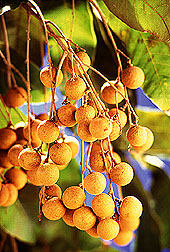This page has been archived and is being provided for reference purposes only. The page is no longer being updated, and therefore, links on the page may be invalid.
Luscious Longans Protected in ARS CollectionBy Marcia WoodOctober 21, 2004 Sweet and crisp-textured, exotic tropical fruits known as longans make a refreshing snack. But you'll want to eat more than merely one, not only because longans are small--a little larger than an olive--but also because their translucent, white flesh is so delicious. The taste and texture of longan and its larger cousin, lychee, have been compared to those of a sweet, peeled grape. America's official collection of wild and domesticated longan trees from around the world is located in Hilo, on Hawaii Island, where it is managed by the Agricultural Research Service, the U.S. Department of Agriculture's chief scientific research agency. This modest collection safeguards longans that might otherwise be lost as older commercial varieties are replaced by newer ones, or as native forests of wild longan fall victim to bulldozers, insects or diseases. Longans are among more than a dozen kinds of tropical crops protected at Hilo in the laboratories, greenhouse, screenhouse and orchards of what is formally known as the ARS National Clonal Germplasm Repository for Tropical and Subtropical Fruit and Nut Crops. Researchers, breeders and other specialists worldwide can use the collection. Longan varieties that make up this living botanical library include Tiger Eye and Ta u Yu from China, where longan is native; Si Chompoo from Thailand; and Hawaii's own Kohala and Egami. Research leader and repository curator Francis T.P. Zee at Hilo and a team led by ARS colleague Paul H. Moore at Aiea, Oahu Island, are probing the genetic makeup of longan. The DNA techniques the team is using will help clarify who's who among the collection's specimens and will resolve some of the confusion that resulted when longan variety names were translated from Chinese into English. |

